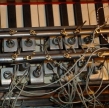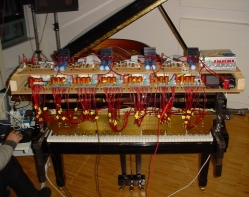Documentation for the speaking piano can be found here.
Summary

The project shown in the above video is called “Quadraturen III: Wirklichkeit” (or “Squarings III: Reality”), created by the composer Peter Ablinger in collaboration with Winfried Ritsch. It makes use of a mechanical piano (where keys are automatically pressed by a machine) to resynthesize sound recordings of humans into “speech” created only from the sound of the piano.
Mechanism

A tool designed in C by Thomas Musil was used to convert the sound recording of an elementary school student into MIDI (Musical Instrument Digital Interface) data that could then be used to control the piano with mechanical switches from Albinger’s computer. Documentation for the construction of the piano (besides the in-process photo to the right and the prototype photo in the Summary section) was difficult to find, but it is likely similar to the design of a modern pianola that is able to recognize MIDI files. From this video of the installation, you can that closer up, the piano keys are physically being pressed with small padded hammers.
Context
In the video, the piano is attempting to replicate the sound recording of an elementary school student reading the Proclamation of the European Environmental Criminal Court from the World Venice Forum of 2009. While not completely understandable by itself, the piano’s speech becomes very recognizable and personified with introduction of captions. Ablinger compares the voice of the piano to “those 3D-pictures where one first sees a mass of abstract ornaments and then – with practice squinting – discovers a three-dimensional object.” The piece exhibits embodied computation through translation of sound coming from human beings to an abstracted (yet eerily similar) sound reproduced by a non-living instrument. This piano is among a series of sound art installations called “Quadraturen” (or “Squarings” in english, named after the appearance of MIDI data after recordings have been severely compressed) produced by Ablinger and has been used to recreate the voices of historical figures, such as Fidel Castro giving the speech “Fidelito/La Revolución y las Mujeres”. Specifically in the speech recreated from Fidel Castro, there are many additional notes produced due to translation of sound from audience members and scratches in the original recording. Ablinger describes the piano as representative of “a mimetic machine which is capable of producing the mimesis of a mimesis: it absorbs, it imitates what has already previously been imitated, namely the recording of sound.”
Since the video at the top of this blog post had captions, here is a link to another script and audio clip of the piano. See if you can hear what it’s saying without and with looking at the text.
Leave a Reply
You must be logged in to post a comment.